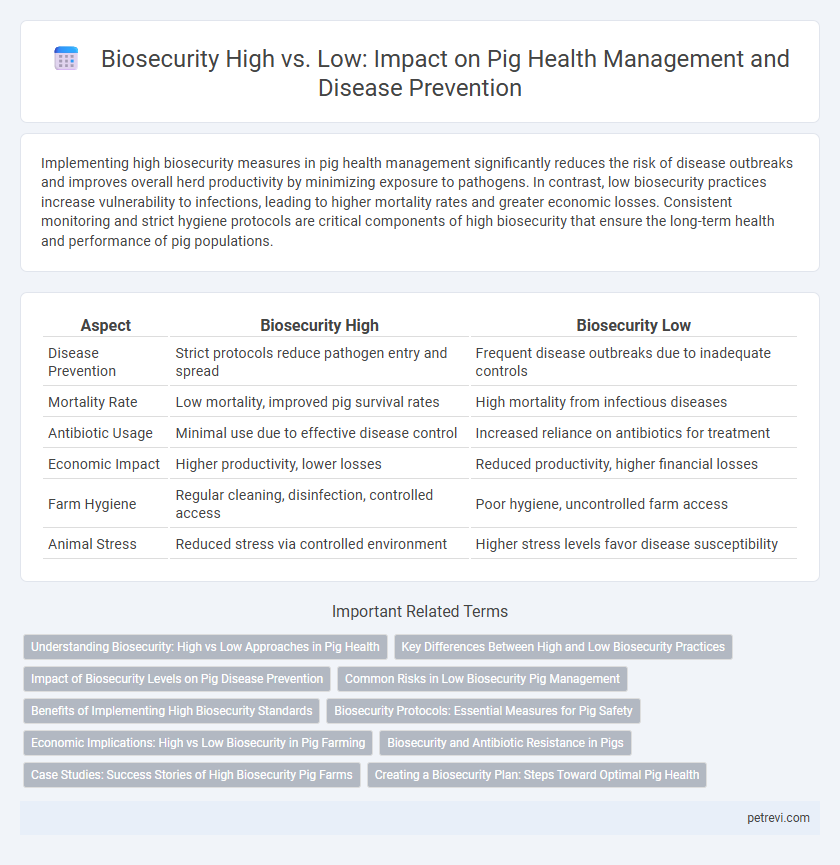Implementing high biosecurity measures in pig health management significantly reduces the risk of disease outbreaks and improves overall herd productivity by minimizing exposure to pathogens. In contrast, low biosecurity practices increase vulnerability to infections, leading to higher mortality rates and greater economic losses. Consistent monitoring and strict hygiene protocols are critical components of high biosecurity that ensure the long-term health and performance of pig populations.
Table of Comparison
| Aspect | Biosecurity High | Biosecurity Low |
|---|---|---|
| Disease Prevention | Strict protocols reduce pathogen entry and spread | Frequent disease outbreaks due to inadequate controls |
| Mortality Rate | Low mortality, improved pig survival rates | High mortality from infectious diseases |
| Antibiotic Usage | Minimal use due to effective disease control | Increased reliance on antibiotics for treatment |
| Economic Impact | Higher productivity, lower losses | Reduced productivity, higher financial losses |
| Farm Hygiene | Regular cleaning, disinfection, controlled access | Poor hygiene, uncontrolled farm access |
| Animal Stress | Reduced stress via controlled environment | Higher stress levels favor disease susceptibility |
Understanding Biosecurity: High vs Low Approaches in Pig Health
High biosecurity in pig health management emphasizes strict controls on farm access, sanitation, and disease prevention measures to minimize pathogen introduction and spread, resulting in improved herd immunity and reduced outbreaks. Low biosecurity practices often involve inadequate sanitation, unrestricted access, and limited disease monitoring, increasing the risk of infections such as Porcine Reproductive and Respiratory Syndrome (PRRS) and swine influenza. Implementing high biosecurity protocols significantly enhances pig welfare, production efficiency, and profitability by maintaining a healthier herd environment.
Key Differences Between High and Low Biosecurity Practices
High biosecurity in pig health management involves strict protocols such as controlled farm access, rigorous sanitation, and comprehensive quarantine measures to prevent disease introduction and spread. Low biosecurity practices often lack these controls, leading to higher risks of pathogen transmission through contaminated equipment, personnel, and unrestricted animal movement. The key differences impact overall pig health, mortality rates, and farm productivity, with high biosecurity significantly reducing disease outbreaks and improving herd performance.
Impact of Biosecurity Levels on Pig Disease Prevention
High biosecurity in pig farms significantly reduces the risk of infectious diseases such as African swine fever, porcine reproductive and respiratory syndrome, and swine influenza by limiting pathogen exposure and transmission. Low biosecurity practices increase vulnerability to disease outbreaks, resulting in higher morbidity, mortality, and economic losses in pig populations. Implementing strict sanitation measures, controlled access, and proper waste management are critical components of effective pig disease prevention through enhanced biosecurity.
Common Risks in Low Biosecurity Pig Management
Low biosecurity in pig management significantly increases the risk of infectious diseases such as porcine reproductive and respiratory syndrome (PRRS), swine influenza, and African swine fever due to poor control of pathogen entry and spread. Inadequate sanitation, uncontrolled visitor access, and improper disposal of waste contribute to the heightened vulnerability to parasites, bacterial infections like Mycoplasma hyopneumoniae, and viral outbreaks. Failure to implement strict biosecurity protocols often results in higher mortality rates, reduced growth performance, and increased veterinary costs for pig producers.
Benefits of Implementing High Biosecurity Standards
Implementing high biosecurity standards in pig health management significantly reduces the risk of infectious disease outbreaks such as African swine fever and porcine reproductive and respiratory syndrome. Enhanced biosecurity protocols limit pathogen transmission through controlled farm access, sanitation practices, and quarantine measures, leading to improved animal welfare and increased herd productivity. Farms with high biosecurity consistently report lower mortality rates, reduced veterinary costs, and better overall growth performance compared to those with low biosecurity levels.
Biosecurity Protocols: Essential Measures for Pig Safety
Implementing high biosecurity protocols in pig health management significantly reduces the risk of infectious disease outbreaks by controlling the movement of people, animals, and equipment within pig farms. Key measures include strict sanitation procedures, quarantine of new or sick pigs, and secure feed and water sources to prevent contamination. Farms with low biosecurity often face higher incidences of respiratory and enteric diseases, leading to increased mortality rates and economic losses in pig production.
Economic Implications: High vs Low Biosecurity in Pig Farming
High biosecurity measures in pig farming significantly reduce disease outbreaks, lowering veterinary costs and improving growth rates, which enhances overall farm profitability. Low biosecurity increases the risk of infections like Porcine Reproductive and Respiratory Syndrome (PRRS), leading to higher mortality rates, production losses, and increased medication expenses. Investing in robust biosecurity protocols yields substantial economic benefits by minimizing downtime and maximizing pig health and productivity.
Biosecurity and Antibiotic Resistance in Pigs
High biosecurity in pig health management drastically reduces pathogen transmission, minimizing the need for antibiotics and thereby curbing antibiotic resistance development. Implementing rigorous sanitization, controlled farm access, and quarantine protocols disrupts disease cycles and limits bacterial exposure. Low biosecurity environments elevate infection risks, prompting increased antibiotic use and accelerating resistance gene propagation among swine pathogens.
Case Studies: Success Stories of High Biosecurity Pig Farms
High biosecurity pig farms consistently demonstrate lower incidence rates of common swine diseases such as PRRS and PEDv, resulting in improved overall herd health and productivity. Case studies from leading operations highlight protocols including controlled farm access, stringent sanitation measures, and regular health monitoring that reduce pathogen transmission. Economically, these farms report higher growth rates and reduced veterinary costs, underscoring the financial benefits of implementing high biosecurity measures.
Creating a Biosecurity Plan: Steps Toward Optimal Pig Health
Creating a biosecurity plan for pig health management involves assessing risks and implementing protocols that separate high biosecurity farms from low biosecurity ones. High biosecurity measures typically include controlled farm access, strict sanitation procedures, and quarantine protocols that significantly reduce the risk of disease transmission such as Porcine Reproductive and Respiratory Syndrome (PRRS) and African Swine Fever (ASF). In contrast, low biosecurity environments often lack these stringent controls, leading to increased vulnerability to infections and subsequent economic losses in pig production.
Biosecurity High vs Biosecurity Low for Pig Health Management Infographic

 petrevi.com
petrevi.com